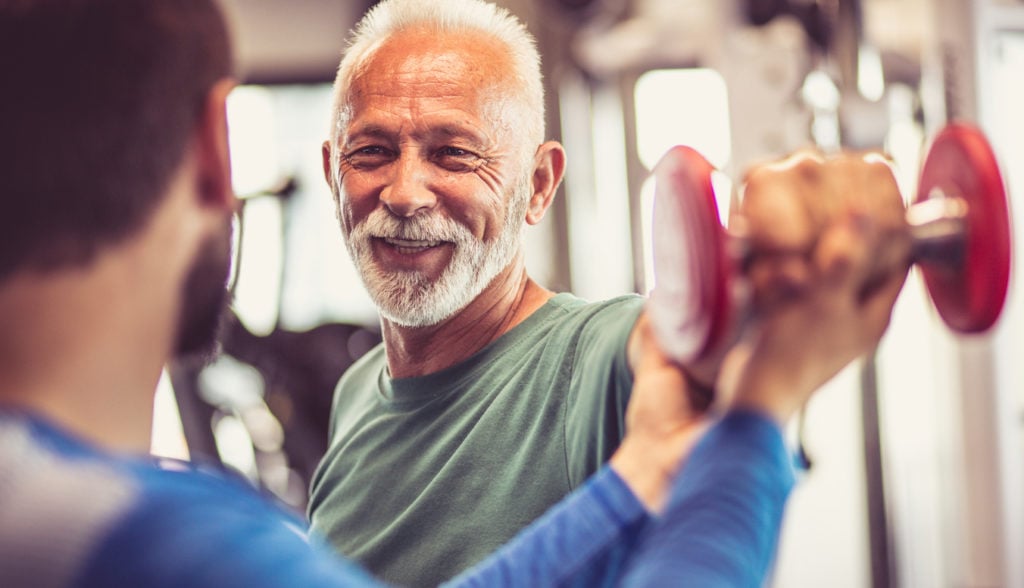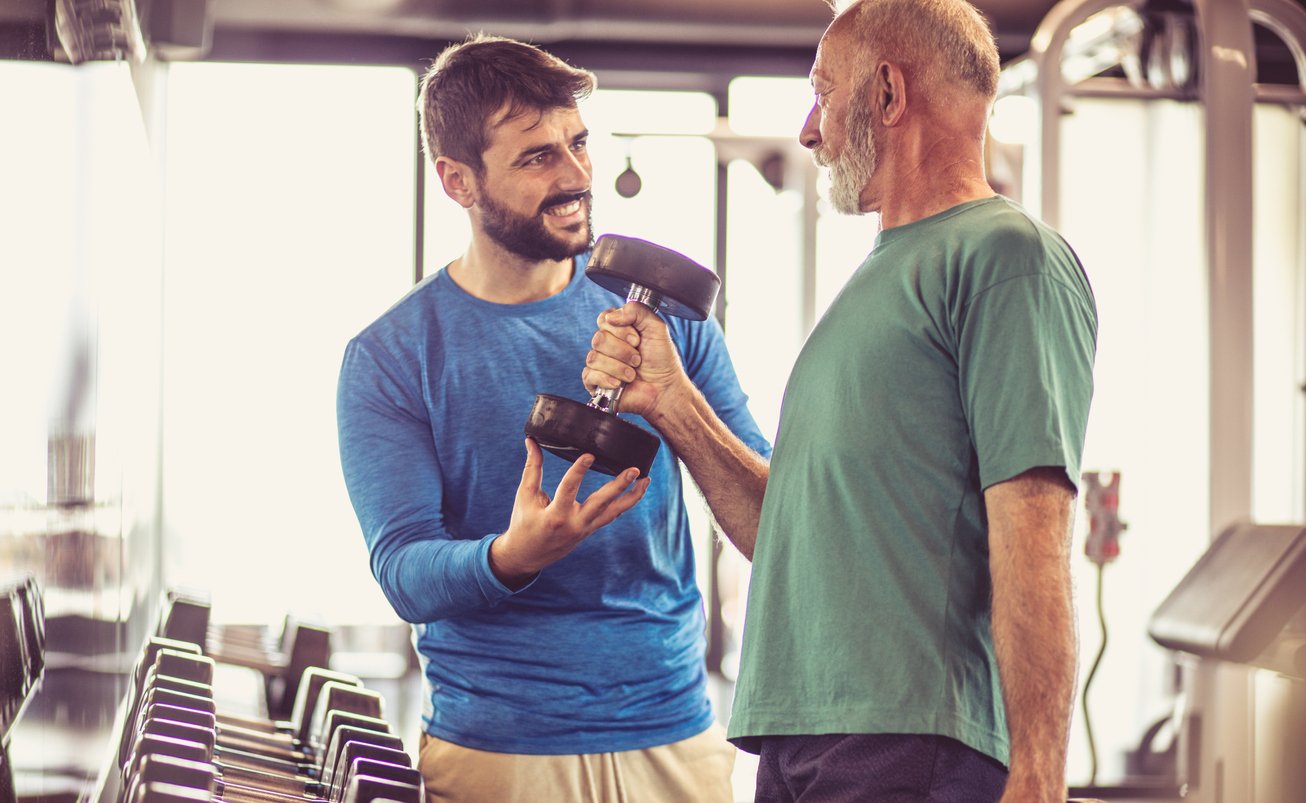“You need good form,” or “technique is everything” are just a couple of the staple statements you hear fitness professionals and strength coaches say.
This is what personal trainers are known and hired for, making sure that the client is using good technique. What happens when a client starts to fatigue and form and technique go out the window? Or, on the flip side, what if an exercise has become too easy?
The trainer’s ability to modify an exercise through regressions or progressions, or what can be called micro-changes, becomes a valuable tool in their training toolbox. These modifications are especially important when training older and younger clients.
Why is good technique important?
When you evaluate three typical goals that a client may have – body composition change, performance enhancement, wellness or general fitness – you will have some form of resistance training in their programming.
Resistance training can happen in multiple ways, whether body weight, free weights, machines, bands and tubing, suspension trainers or the endless variety of modalities and equipment choices on the market place. No matter the choice, safety and effectiveness of the exercise are important. No one wants to put themselves in harm's way by doing an exercise incorrectly or waste their time on an exercise program that won’t achieve their goals.
Using posture during training is a matter of keeping joints aligned to where an ideal sequence of muscular contractions can occur. Consider the push-up as an example, in the prone position with the arms extended ideal alignment will mean that the kinetic chain checkpoints, ears, shoulders, hips, knees, and ankles, will all be in one line, both while descending and ascending during the rep and throughout the set.
As fatigue sets in and the checkpoints start to migrate away from the initial set up alignment, unwanted muscular involvement and increased joint stress may occur. If the low back starts to arch or sag, this could mean decreased engagement of the deeper core stabilizers, increased involvement of the lumbar erectors and increased stress on the vertebral discs.
Understanding and implementing the kinetic chain checkpoints and translating it to other movements will improve muscular recruitment while decreasing excess stress on joints. Again, with push-ups as an example, if the fitness professional identifies the low back arch compensation, they can regress the movement to maintain ideal alignment and continue the exercise program safely.
What is exercise regression and progression?
An exercise regression is simply an approach to decrease the demand of an exercise or movement. Conversely, a progression does the opposite by increasing the demand incrementally through minor changes.
There are many benefits to using regressions and progressions during a workout,
these include:
- Maintains client confidence. Have
you ever heard a client say, “I can’t do push-up’s,” or “That exercise hurts my
back”? If you know how to make an exercise easier you are sure to find a
version of that motion that a client can execute. A push-up with hands on the
kitchen counter or on the wall is still a push-up. Now it’s just a matter of
gradually progressing their torso to the floor to get them closer to a
traditional push-up. - Immediate adjustments. If you’ve
ever trained a group you know that no one comes in with the same range of
motion, strength or endurance. Someone who loses postural integrity and starts
compensating needs to adjust their technique – and fast. Often times, there is
no time or alternative equipment available to accommodate lighter weight or
resistance. - Shared space or equipment. If you’re in a gym and it’s prime time there are times you don’t have access to the tools or weights you may typically use. Instead of the 20# dumbbells you may have planned to use, all that might be sitting on the rack is the 15# or 25#. The question now becomes how do your progress the 15# or regress the 25#.
5 variable that influence micro changes
Here are five variables that influence micro changes.
- Intensity / Load
- Range
- Height
- Speed
- Body Position
Intensity / Load
When fatigue starts to set in, one instinctive adjustment most people know to do is to go lighter. If it’s too easy or light they’ll grab the heavier weight or adjust the pin lower down in the weight stack.
Adjusting load can be done across most modalities. If the resistance selection
is limited or restricted, a trainer can add manual resistance or assistance, if
safe for both client and trainer.

Range
How far to go in a movement will be determined by the depth or distance one can go through with “full, available, pain-free range of motion without compensation.” If they can keep the kinetic chain checkpoints correctly aligned they are free to move through the full range of motion the joint will allow.
If during the squat the torso angle can be maintained parallel to the shin angle, neutral lumbar spine and hip, knee and toes in alignment there is no reason to limit resisted movement. However, should knees excessively adduct, loss of neutral spinal position or change in trunk angle relative to the shin angle, then modifications need to be made to keep the intended posture.
Controlling range of motion is the easiest change to be made when needed during a working exercise set. Have the client move to 90%, 80% or even 50% of the initial range of the exercise or where they can maintain the safest posture during the exercise. It’s during the next set that they can adjust to a lighter workload if necessary.
The range can also mean distance away from the initial starting point. When performing a lunge the distance initially is a half stride length forward from the starting position.
If the exercise was performed with perfect technique and with control, the client can step to ¾ stride length to increase intensity and to full stride length if movement integrity is maintained from there. Naturally decreasing this distance can be done for someone who is losing ideal posture.
Height
Height or elevation can be changed for stepping up as you would onto a box or even reaching different levels like hip, shoulder or eye level when performing a lateral shoulder raise. The context generally is relative to the height from the floor.
In the example of a lateral shoulder raise you can start off strong with full range of motion and raise the dumbbells up to the height of the shoulders. Should shoulders start to protract, head move forward or even low back arch, the height of the lateral raise could be modified to where the hands raise up to mid-rib height or the range a client can maintain ear, shoulder and low back in position.
Speed
Speed kills. This is especially true when it comes to using momentum to help lift a weight to a specific height distance (i.e., the big backward sway of the trunk in order to gain speed to get the pulldown bar to the chest).
Having a client slow the speed of the implement down puts the muscle under tension for a longer period of time. This can also create more demand for regional stabilizers if there are enough slower tempo repetitions.
Body Position
Changing body position is probably the easiest of the five to manipulate in order to create greater challenge or ease of a movement.
It’s just a matter of changing position as it relates to gravity or
direction of resistance, or both. Here are examples of basic movements regressed
or progressed.
Push-up
Regressions: Hands on a bench
or knees on the floor
Progression: Elevate
feet onto 6 inch box
Standing Scaption
Regression: Stand more
upright
Progression: Greater
flexion at the hip
Quadruped Hip Extension
Progression: Increase distance between hands and knees (move toward push-up position)
Understanding kinetic chain checkpoints, optimal body alignment and exercise specific postures is integral to making a good exercise program great. Creating exercise programs is the easier part of a fitness professional’s job.
Executing and being able to identify when a movement is done incorrectly and how to fix it is where a trainer earns their keep. A good exercise done incorrectly is no better than an inefficient exercise done perfectly.
References:
NASM (National Association of Sports Medicine). 2019. NASM Essentials of Personal Fitness Training (6th ed.). Burlington, MA: Jones & Bartlett Learning.

















